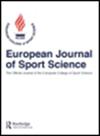不论恢复方式如何,中等持续和高强度间歇训练对中年男性心血管的影响相当。
IF 2.4
3区 医学
Q2 SPORT SCIENCES
引用次数: 0
摘要
评估高效高强度间歇训练(HIT)中主动和被动间歇内恢复模式对久坐中年男性心肺健康、自主神经功能和内皮功能的影响。参与者(n = 62;年龄:49.5±5.8岁;BMI: 29.7±3.7 kg·m-2)完成心肺适能、血流介导的舒张(FMD)和心率变异性的评估,然后随机分配到对照组(CON;n = 14)、中等强度连续训练(MICT;n = 15), HIT与被动(P-HIT;n-15)或主动恢复(A-HIT;n = 15)。参与者每周进行三次锻炼,持续12周。MICT以60-70%的最大心率(HR)完成50-60分钟的连续骑行。HIT完成30秒的工作间隔(~ 85% HR),间隔2.5分钟的主动或被动恢复。所有运动方式均增加了氧摄取(V / O2) (MD:≥3.1 ml·kg-1·min-1, 95%CI: 1.5 ~ 4.7 ml·kg-1·min-1;p p p p p≤0.05)。对久坐不动的中年男性进行为期12周、每周三次的运动干预后,时间效率高的HIT可以显著改善心肺健康、FMD和自主神经调节。在连续的高强度间歇期之间的主动恢复在这个条件不佳的队列中没有提供额外的益处。本文章由计算机程序翻译,如有差异,请以英文原文为准。
Moderate continuous- and high-intensity interval training elicit comparable cardiovascular effect among middle-aged men regardless of recovery mode.
ABSTRACT To assess the effect of active and passive intra-interval recovery modes in time-efficient high-intensity interval training (HIT) on cardiorespiratory fitness, autonomic function, and endothelial function in sedentary middle-aged men. Participants (n = 62; age: 49.5 ± 5.8 y; BMI: 29.7 ± 3.7 kg·m−2) completed the assessments of cardiorespiratory fitness, flow-mediated dilation (FMD) and heart rate variability before being randomly allocated to control (CON; n = 14), moderate intensity continuous training (MICT; n = 15), HIT with passive (P-HIT; n-15), or active recovery (A-HIT; n = 15). Participants performed thrice weekly exercise sessions for 12 weeks. MICT completed 50–60 min of continuous cycling at 60–70% heart rate (HR) maximum. HIT completed 30-s work intervals (∼85% HR) interspaced with 2.5 min of active or passive recovery. All exercise modalities increased oxygen uptake (V̇O2) (MD: ≥ 3.1 ml·kg−1·min−1, 95%CI: 1.5–4.7 ml·kg−1·min−1; P < 0.001), power output (MD: ≥ 26 W, 95%CI: 15–37 W; P < 0.001) and cycle duration (MD: ≥ 62 s, 95%CI: 36–88 s; P < 0.001) at 85% HRM. Significant pre-to-post differences were observed among all exercise groups for FMD (MD: ≥ 3.4%, 95%CI: 0.3–6.5%; P < 0.05), while MICT and P-HIT significantly increased the standard deviation of all NN intervals (SDNN) pre-to-post intervention (MD: ≥ 7 ms, 2–13 ms; P ≤ 0.05). Time-efficient HIT elicits significant improvements in cardiorespiratory fitness, FMD and autonomic modulation following a thrice weekly 12-week exercise intervention among sedentary middle-aged men. Active recovery between successive high-intensity intervals provided no additional benefit among this deconditioned cohort.
求助全文
通过发布文献求助,成功后即可免费获取论文全文。
去求助
来源期刊
CiteScore
6.60
自引率
3.10%
发文量
153
审稿时长
6-12 weeks
期刊介绍:
The European Journal of Sport Science (EJSS) is the official Medline- and Thomson Reuters-listed journal of the European College of Sport Science. The editorial policy of the Journal pursues the multi-disciplinary aims of the College: to promote the highest standards of scientific study and scholarship in respect of the following fields: (a) Applied Sport Sciences; (b) Biomechanics and Motor Control; c) Physiology and Nutrition; (d) Psychology, Social Sciences and Humanities and (e) Sports and Exercise Medicine and Health.

 求助内容:
求助内容: 应助结果提醒方式:
应助结果提醒方式:


